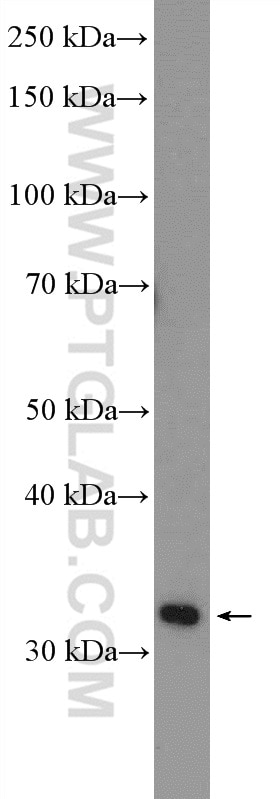LRRC38 Polyklonaler Antikörper
LRRC38 Polyklonal Antikörper für WB,ELISA
Wirt / Isotyp
Kaninchen / IgG
Getestete Reaktivität
human, Maus
Anwendung
WB,ELISA
Konjugation
Unkonjugiert
Kat-Nr. : 55479-1-AP
Synonyme
Galerie der Validierungsdaten
Geprüfte Anwendungen
| Erfolgreiche Detektion in WB | RAW 264.7-Zellen |
Empfohlene Verdünnung
| Anwendung | Verdünnung |
|---|---|
| Western Blot (WB) | WB : 1:200-1:1000 |
| It is recommended that this reagent should be titrated in each testing system to obtain optimal results. | |
| Sample-dependent, check data in validation data gallery | |
Produktinformation
55479-1-AP bindet in WB,ELISA LRRC38 und zeigt Reaktivität mit human, Maus
| Getestete Reaktivität | human, Maus |
| Wirt / Isotyp | Kaninchen / IgG |
| Klonalität | Polyklonal |
| Typ | Antikörper |
| Immunogen | Peptid |
| Vollständiger Name | leucine rich repeat containing 38 |
| Berechnetes Molekulargewicht | 32 kDa |
| Beobachtetes Molekulargewicht | 32 kDa |
| GenBank-Zugangsnummer | XM_001713942 |
| Gene symbol | LRRC38 |
| Gene ID (NCBI) | 126755 |
| Konjugation | Unkonjugiert |
| Form | Liquid |
| Reinigungsmethode | Antigen-Affinitätsreinigung |
| Lagerungspuffer | PBS mit 0.02% Natriumazid und 50% Glycerin pH 7.3. |
| Lagerungsbedingungen | Bei -20℃ lagern. Aliquotieren ist bei -20oC Lagerung nicht notwendig. 20ul Größen enthalten 0,1% BSA. |
Hintergrundinformationen
The large-conductance, calcium- and voltage-activated potassium (BK) channels are characterized by their large conductance of potassium ions (K+) through cell membranes. BK channels are widely expressed with diverse functions in different tissues or cell types, consisting of the pore-forming, voltage- and, calcium-sensing alpha subunits, either alone or in association with regulatory subunits (PMID: 25360119; 22547800). LRRC38 belongs to the gamma family of BK channel accessory subunits that regulate channel gating properties.
Protokolle
| Produktspezifische Protokolle | |
|---|---|
| WB protocol for LRRC38 antibody 55479-1-AP | Protokoll herunterladen |
| Standard-Protokolle | |
|---|---|
| Klicken Sie hier, um unsere Standardprotokolle anzuzeigen |


